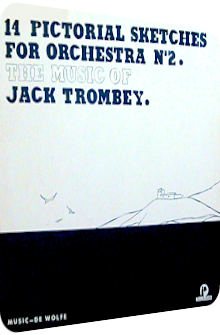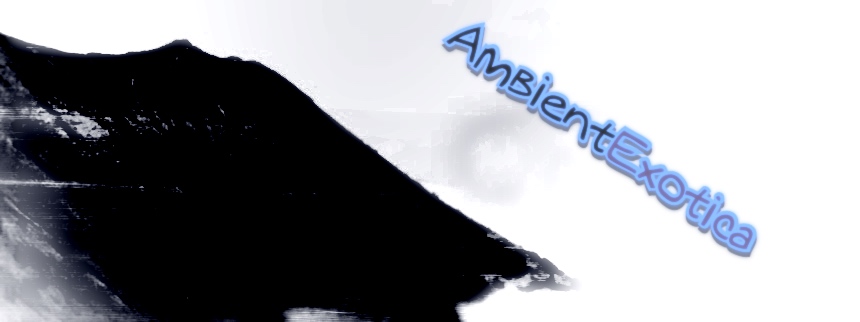
Jack Trombey
14 Pictorial Sketches
For Orchestra No. 2
1970
Fourteen Pictorial Sketches For Orchestra No 2 is a seemingly self-explanatory collection of library music for use in advertisements, films, musicals or other creative productions, written by Dutch composer Jack Trombey (born 1927 as Jan Stoeckart) and released on the famous label DeWolfe Music specializing in library music, sporting more than 80,000 titles (… and counting) in their ever-expanding archives. My take on library music is this: if it is splendidly realized and offers convincing sub-themes or structures, I dig it, man. This particular release as played by the International Studio Orchestra is another half-gem, as Trombey’s arrangements are known for their cinematography and huge wideness. Indeed, if some of the tunes would occur in movies such as Pirates Of The Caribbean, listeners would not notice anything cheap or frantic about them while they are in sync with the photography.
Whereas Tromsey’s label mates such as Anthony Mawer and Peter Reno write Space-Age and Exotica music in bold colors, Jack Trombey’s ones are often much more powerful and dun-colored. Turns out that the mirthful pieces are the lackluster ones, the cinematic over-the-top ones, however, are fantastic. But there is another reason I am reviewing this work out of the thousands of the back catalog, one which I will not reveal until the end of the review (but don’t scroll down yet!), for it shows the falsifiable aura of mediocrity that is emanated by library music. Here it is the title of the album, one which I have just called “seemingly self-explanatory” in the introductory sentence, but there is much more to it than a simple-minded gallimaufry of 14 titles. Trombey or the managers of DeWolfe missed an opportunity here, and you may know what I am hinting at over the course of this review. Anyway, here is a closer look at the exclusively unique material.
Marrying exotic allusions with the grandiloquence of anthems such as Granada, the opener Seapaths Of The World launches with a military march-like cymbal structure and a kettle drum galore. The horns are utterly compatible to an epic film about the Roman empire, as they gleam, glow and insinuate the wide ocean at the same time. A few strings spiral around the walls of brass, adding the necessary aquatic element to the tune. Believe it or not, but the melodrama works well, evokes danger and majesty at the same time. Straits Of Singapore remains in a liquid state as Jack Trombey’s composition adds gallons of pentatonicism to the glockenspiel- and xylophone-aided and utterly exotic vista. Flute tones, towering brass fanfares, harp spirals and string washes round off the delightfully dualistic take of mystique and adventure.
Whereas Unknown Horizons is the centerpiece of over seven minutes and even made it to The Avalanches’ Summer Crane off their exotic sample manifesto Since I Left You (2000) due to the Far Eastern flute billows and the gargantuan brass stabs of the utmost cinematic kind, Cape Horn is another truly ambivalent piece with not one cloudlet in sight at first, but then confronting the listener with its military march structure and the crepuscular horn acidity. In The Mediterranean then turns out to be the first truly joyous take on the album, and it suffers from the fairy tale flute notes in the middle and can only enchant via its string backdrop. The Dead Sea is a largely percussion-less piece that sports a four-note flute helix, clarinet coils and a kind of arcane amazement complete with sunlight-reflecting water masses as transformed into music via glockenspiel glints, whereas the last piece of side A, Homeward Bound, lives up to its description as a “bright, optimistic movement” as it is a cinematic piece about the homecoming, clearly made for a pirate movie or any genre that features swashbuckling adventurers of your choice.
Side B opens with the picturesque Butterflies which depicts outdoor meadows via maraca-backed flute melodies. The lachrymose strings augment the chintzy cliché of this ultimately bad piece. It cannot win when Jack Trombey unleashes his cinematic pieces such as the following Soldier And The Girl which is equally torn between a blithesome day via the swooshing glissando of the strings and a more manly approach that is shown by piercing horns and clinging tambourines. King And The Nightingale, however, works really well with its string-focused approach, as the harp movement and the whirling flutes do the fabulous fable justice. Fir-green and sylvan, it is less exotic than it is bound in Space-Age lands.
A touch of blue is added to Mermaids, the only partially comical and exhilarative composition that works on this album; staccato elements such as pizzicato strings, castanets and tambourines depict life under the sea years before Disney came up with an interpretation of this topic. Porcelain Statues features the same physiognomy and draws a spring-like location that seems compatible with the movements of practising ballerinas, with the following Chinese King returning to the cinematic megalomania: horns en masse, strings and pentatonic xylophones make this an truly exotic piece that could have been spawned by Les Baxter and fittingly placed in Ports Of Pleasure (1957). The finale Prince And The Girl creates a Zorba The Greek-like folklore atmosphere of the enchanting kind with languorous strings and two-note rhythm horns. This one truly feels like a happy end finale, so I dare you to let the credits of your movie production roll over this piece to cause teary-eyed attendants.
Jack Trombey’s orchestrations are huge and genuinely cinematic, so this could be the library music to own if you are fond of a truly large wideness and smashing constructions akin to Alfred Newman’s and Ken Darby’s Ports Of Paradise (1960) or Stanley Wilson’s Pagan Love (1961) which mix piercing counterparts and ginormous horns into their otherwise susurrant hymns. There is anything wrong with the long-winded Fourteen Pictorial Sketches For Orchestra music-wise, as it delivers the expected oscillations between true greatness (Seapaths Of The World, Unknown Horizons) and overly schmaltzy summer landscapes (Butterflies, Porcelain Statues).
Heck, there are even gorgeous Far Eastern tone sequences interwoven as Straits Of Singapore and Chinese King astutely show, but the large amount of material does not equal greatness, at least not on the album formula. Even though this is “just” library music, DeWolfe Music artists are usually proud to carve out an overarching theme that guides the songwriting process as well as the potential designer or agency which picks up the respective album in order to underline the production with music. The oddest thing to attest is this: Jack Trombey does have a remarkable theme at hand, but neither realizes this nor cares about it. Fourteen Pictorial Sketches For Orchestra does sport one particular scheme which could have been extrapolated better, and that is the scheme of water and the ocean!
So many compositions have water-related markers in their titles, but Trombey does not draw the connection by featuring a whopping 14 songs dedicated to this topic, nor does he mark this in the album title. Fans of Les Baxter’s Jewels Of The Sea (1960) who long for another dose of aquatastic Space-Age could investigate though. The album has only ever released on vinyl and never been reissued, but who knows what might happen in the future, with DeWolfe Music still alive and their reissue machinery well-oiled.
Exotica Review 497: Jack Trombey – 14 Pictorial Sketches For Orchestra No. 2 (1970). Originally published on Jul. 27, 2018 at AmbientExotica.com.
